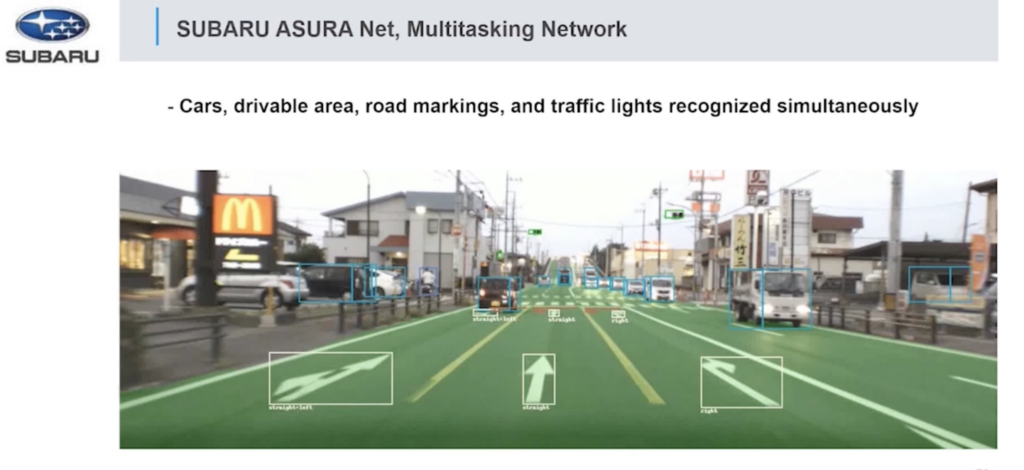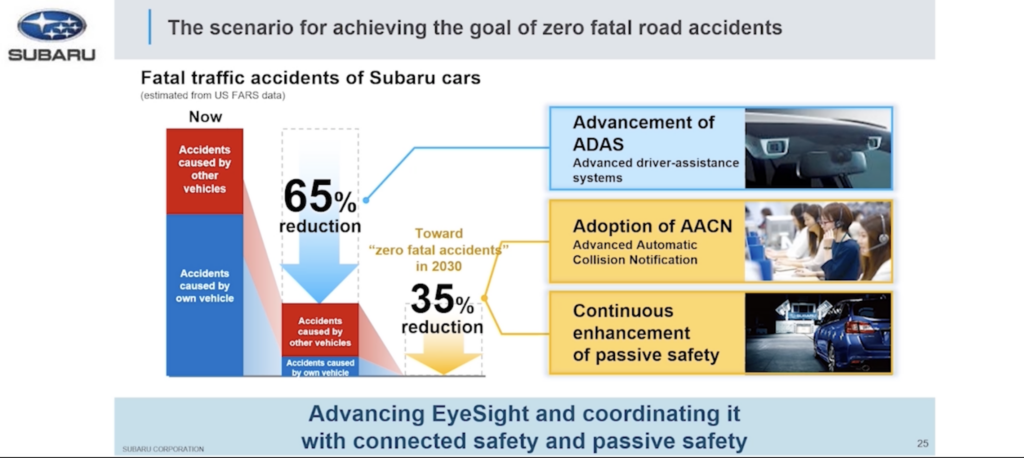
Subaru, Volvo take different approaches to applying AI to vehicle safety systems
By Dave LaChance onAnnouncements | Technology
Volvo and Subaru are both incorporating artificial intelligence (AI) into their vehicles’ safety technologies, though the two OEMs are taking different approaches.
Subaru is building AI into its EyeSight advanced driver assistance system (ADAS) technology, to interpret elements in the vehicle’s environment that are detected by the system’s stereo cameras.
At the same time, Volvo has announced that its recently launched EX90 all-electric SUV will be equipped with a system that uses AI to process data from real-life incidents to develop improved software that will make the vehicle safer over time.
Subaru’s AI technology, intended to launch in 2025 as part of the OEM’s goal of zero traffic fatalities by 3030, provides real-time analysis of the vehicle’s driving environment, Toru Saito, Deputy Director of the Subaru Lab, said in a video briefing.
The Subaru Lab, opened in Tokyo’s high-tech Shibuya district in December 2020, was created to develop ways to apply machine learning to vehicle safety.
Saito said the AI-augmented system is able to accurately detect a roadway, even when it’s obscured by snow, or lacks lane markings. It also recognizes everything above that surface as an obstacle, and uses AI to identify those obstacles.
Other systems, he said, can only recognize specific obstacles, requiring one algorithm to detect vehicles, for instance, and another to detect pedestrians. The AI “works quite well with stereo camera technology,” he said. “By using the stereo cameras for object detection, we can see everything in the space. That’s what sets us apart.”
Because automotive systems must limit their power consumption, Subaru’s Asura Net network employs multi-tasking to process sensor inputs. Saito likened it to a backbone connected to 20 “heads,” representing various types of data inputs.
The challenge for AI, Saito said, is that it only knows what it has been taught. For instance, he said, it was not able to identify a person walking out from behind a vehicle on a highway, because that’s something that’s seldom seen in real life.
Another example, he said, was that of a person lying in a road. The EyeSight cameras can detect that there’s something in the road ahead, but cannot say if it’s something the vehicle can pass over safely, or must stop for. AI can answer that question, using its ability to “finely classify things,” he said.
By combining cameras and AI, Saito said, “we believe we can develop sensors that are robust against the unknown.”
Subaru provided the briefing as it marked the milestone of selling 5 million vehicles equipped with EyeSight systems since the technology was introduced in 2008. The OEM says EyeSight-equipped models account for about 91% of its sales worldwide, and 96% in the U.S.
Eiji Shibata, Director of the Subaru Lab, said vehicles equipped with EyeSight are involved in 61% fewer accidents involving injury or death as cars without EyeSight, and 84% fewer rear-end collisions.
EyeSight-equipped vehicles are also 65% less likely to be involved in fatal accidents, Shibata said. He said the OEM is pursuing its goal of zero fatalities by continually enhancing its passive safety systems, and by adopting Advanced Automatic Collision Notification (AACN) to get medical help to accident victims as quickly as possible.
The newest generation of EyeSight, introduced in 2020, includes all new hardware, including a third camera with a wide angle of view and four radar sensors located in the front and rear bumpers. Increased data processing capacity and coordination allow for enhanced accident avoidance, Shibata said.
Volvo
Volvo on Monday introduced OnePilot, its AI-powered software that it says will offer drivers added security. OnePilot, developed by software company Zenseact, is included on the OEM’s new EX90, released Nov. 9.
According to Zenseact, OnePilot is intended to have ADAS and autonomous driving capabilities. The OEM called it “a significant step in the company’s ambition to reduce traffic accidents and create safe roads for everyone.”
Volvo said OnePilot will learn from human behavior to improve vehicles’ safety performance. “The predictive safety principle, a set of threat assessment, decision-making, and verification practices that enhance traffic safety, frames the technology training the software to anticipate and avoid complex traffic situations, much like humans would,” it said.
The technology will store data from real-life incidents recorded by the cars’ sensors, which will form the basis of machine learning and future updates. In that way, continuous development of the software will make the vehicles safer over time, Volvo said.
“The launch of the Volvo EX90 featuring OnePilot is a milestone in automotive safety. Through its continuous data gathering, the Volvo EX90 will provide us with data from real-world in combination with simulated scenarios, helping us progress towards zero collisions faster,” Ödgärd Andersson, CEO of Zenseact, said in a news release.
The EX90 is equipped with eight cameras, five radars, 16 ultrasonic sensors, and a roof-mounted lidar sensor to create a 360-degree real-time view. Volvo said the lildar sensor will be capable of producing a 3D “point cloud” around the vehicle at up to 820 feet ahead.
OnePilot includes three modes of operation: Drive, Cruise, and Ride. Drive mode is always on, assisting an active driver, while Cruise involves autonomous driving elements under the driver’s supervision. Ride mode is “a fully autonomous solution” that is “at the data capture stage,” but has not yet been activated.
“Volvo Cars is proud to have Zenseact’s cutting-edge technology in the new Volvo EX90, helping to create an invisible shield of safety for drivers,” Elsa Eugensson, Senior Program Manager AD & ADAS at Volvo Cars, said in a news release.
More information
Subaru’s EyeSight to incorporate AI; goal is safety, not autonomous driving
Images
Featured image: Subaru is incorporating artificial intelligence into its EyeSight technology to help realize preventative safety against obstacles. (Provided by Subaru Lab)


